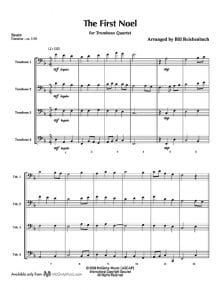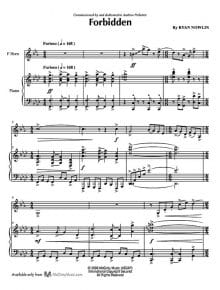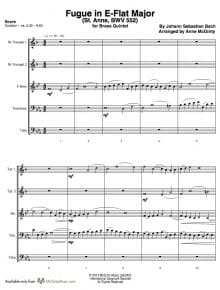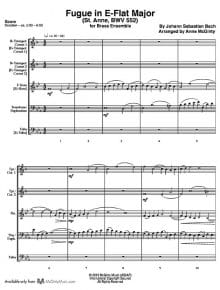Search Music
Music Categories
PDF Download Only
Purchase. Print. Play.
-
First Noel, The – Trombone Quartet
This traditional carol is arranged with reverent simplicity and beautiful textures.
Composer: Bill Reichenbach
Instrumentation: 3 Tenor Trombones and 1 Bass Trombone
Duration/# of Pages: ca. 1:30 / 8 pages, 8.5″ x 11″
Key: F -
Forbidden – Horn and Piano
Commissioned by Grammy-award winning horn player Andrew Pelletier, this very fast-paced and highly energetic piece draws its inspiration from the final moments of Johann Wolfgang von Goethe’s fly in his poem: The Death of the Fly (1810).
“WITH eagerness he drinks the treach'rous potion,
Nor stops to rest, by the first taste misled;
Sweet is the draught, but soon all power of motionHe finds has from his tender members fled;
No longer has he strength to plume his wing,
No longer strength to raise his head, poor thing!
E'en in enjoyment's hour his life he loses,
His little foot to bear his weight refuses;
So on he sips, and ere his draught is o'er,
Death veils his thousand eyes for evermore.”Premiered in 2006 on Andrew Pelletier’s recital entitled American Journey at Bowling Green State University, this piece begins as the fly takes his first sip of the forbidden potion. The simultaneous euphoria and terror is explored as the fly realizes his fate. With one final hurrah, he finishes his drink and “death veils his thousand eyes for evermore.”
The audio excerpt is from the live premiere performance, Andrew Pelletier, soloist. (Used with permission.)
Composer: Ryan Nowlin
Instrumentation: F Horn & Piano
Duration/# of Pages: ca. 4:35 / 19 pages, 8.5″ x 11″
Key: N/A -
Fugue in E-Flat Major (J.S. Bach) – Brass Quintet
“The triple fugue … is a symbol of the Trinity. The same theme recurs in three connected fugues, but each time with another personality. The first fugue is calm and majestic, with an absolutely uniform movement throughout; in the second the theme seems to be disguised, and is only occasionally recognisable in its true shape, as if to suggest the divine assumption of an earthly form; in the third, it is transformed into rushing semiquavers as if the Pentacostal wind were coming roaring from heaven.” ~ Albert Schweitzer
The Fugue in E-Flat Major (BWV 552) has become known in English-speaking countries as the “St. Anne” because of the first theme's resemblance to the St. Anne hymn O God, Our Help in Ages Past, a hymn that would have been unknown to Bach. A fugue in three sections of 36 bars, 45 bars and 36 bars, with each section a separate fugue on a different theme, it has been called a triple fugue, although only the first theme is combined with the second and third themes; for that reason the second and third sections are sometimes referred to as double fugues. The number three is pervasive and has been understood to represent the Trinity. The description of Albert Schweitzer follows the nineteenth century tradition of associating the three sections with the three different parts of the Trinity. The number three, however, occurs many other times: in the number of flats of the key signature; in the number of sections; and in the number of bars in each section, each a multiple of 3 x 3. Each of the three themes of the fugues seems to grow from the previous ones.
Written for organ, the ranges of each of the five fugal voices works well for the five brass instruments. Articulations and minimal dynamic suggestions have been added to honor the music, to make it sound as it would have sounded if the fugue were conceived for these modern instruments. The tuba can play m. 114 to the end down an octave to sound more like an organ pedal.
This fugue is available for brass ensemble as well as brass quintet There are Eb trumpet parts included with the brass quintet version. The brass ensemble version has the traditional brass quintet parts, Eb trumpet parts, Eb horn, Euphonium TC and Eb tuba.
The mp3 excerpt is from the Tower Brass Quintet CD, Road Trip. (Used with permission.)
Composer: Anne McGinty
Instrumentation: 2 Bb and/or Eb Trumpets, F Horn, Trombone & Tuba
Duration/# of Pages: ca. 5:30 / 28 pages, 8.5″ x 11″
Key: Eb -
Fugue in E-Flat Major (J.S. Bach) – Large Brass Ensemble
“The triple fugue … is a symbol of the Trinity. The same theme recurs in three connected fugues, but each time with another personality. The first fugue is calm and majestic, with an absolutely uniform movement throughout; in the second the theme seems to be disguised, and is only occasionally recognisable in its true shape, as if to suggest the divine assumption of an earthly form; in the third, it is transformed into rushing semiquavers as if the Pentacostal wind were coming roaring from heaven.” ~ Albert Schweitzer
The Fugue in E-Flat Major (BWV 552) has become known in English-speaking countries as the “St. Anne” because of the first theme's resemblance to the St. Anne hymn O God, Our Help in Ages Past, a hymn that would have been unknown to Bach. A fugue in three sections of 36 bars, 45 bars and 36 bars, with each section a separate fugue on a different theme, it has been called a triple fugue, although only the first theme is combined with the second and third themes; for that reason the second and third sections are sometimes referred to as double fugues. The number three is pervasive and has been understood to represent the Trinity. The description of Albert Schweitzer follows the nineteenth century tradition of associating the three sections with the three different parts of the Trinity. The number three, however, occurs many other times: in the number of flats of the key signature; in the number of sections; and in the number of bars in each section, each a multiple of 3 x 3. Each of the three themes of the fugues seems to grow from the previous ones.
Written for organ, the ranges of each of the five fugal voices works well for the five brass instruments. Articulations and minimal dynamic suggestions have been added to honor the music, to make it sound as it would have sounded if the fugue were conceived for these modern instruments.
This fugue is available for brass quintet as well as brass ensemble. There are Eb trumpet parts included with the brass quintet version. The brass ensemble version has the traditional brass quintet parts, Eb trumpet parts, Eb horn, Euphonium TC and Eb tuba.
Composer: Anne McGinty
Instrumentation: 2 Bb and/or Eb Trumpets, F and/or EbHorn, Trombone and/or Euphonium & Tuba
Duration/# of Pages: ca. 5:30 / 38 pages, 8.5″ x 11″
Key: Eb




